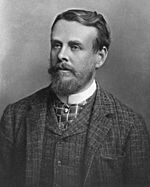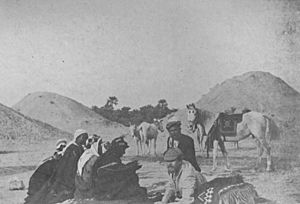James Theodore Bent facts for kids
Quick facts for kids
James Theodore Bent
|
|
|---|---|

James Theodore Bent
|
|
| Born | 30 March 1852 Liverpool, Merseyside, England
|
| Died | 5 May 1897 (aged 45) London, England
|
| Nationality | English |
James Theodore Bent (30 March 1852 – 5 May 1897) was an English explorer, archaeologist and author.
Biography
James Theodore Bent was born in Liverpool on 30 March 1852, the son of James Bent of Baildon House, Baildon, near Bradford, Yorkshire, where Bent lived in his boyhood. He was educated at Malvern Wells preparatory school, Repton School and Wadham College, Oxford, where he graduated in 1875. His uncle Sir John Bent, the brewer, was Liverpool mayor in 1850-51. In 1877 Bent married Mabel Hall-Dare who became his companion, photographer and diarist on all his travels. He went abroad every year and became thoroughly acquainted with Italy and Greece. In 1879 he published a book on the republic of San Marino, entitled A Freak of Freedom, and was made a citizen of San Marino; in the following year appeared Genoa: How the Republic Rose and Fell, and in 1881 a Life of Giuseppe Garibaldi. He spent considerable time in the Aegean archipelago, of which he wrote in The Cyclades; or, Life among the Insular Greeks (1885).

Archaeological research
From this period Bent concentrated particularly on archaeological and ethnographic research. The years 1883-1888 were devoted to investigations in the Eastern Mediterranean and Anatolia, his discoveries and conclusions being communicated to the Journal of Hellenic Studies and other magazines and reviews; his investigations on the Cycladic island of Antiparos are of note. In 1889 he undertook excavations in the Bahrein Islands of the Persian Gulf, looking for evidence that they had been a primitive home of the Phoenician civilization; he and his wife returned to England via Persia (Iran), being introduced to Shah Naser al-Din Shah Qajar along the way. After an expedition in 1890 to Cilicia Trachea, where he obtained a valuable collection of inscriptions, Bent spent a year in South Africa, with the object, by investigation of some of the ruins in Mashonaland, of throwing light on the vexed question of their origin and on the early history of East Africa. To this end, in 1891, he made, along with his wife and the Glaswegian surveyor Robert McNair Wilson Swan (1858-1904), a colleague from Bent's time on Antiparos in 1883/4, the first detailed examination of the Great Zimbabwe. Bent described his work in The Ruined Cities of Mashonaland (1892). In 1893 he investigated the ruins of Axum and other places in northern Ethiopia, which had previously been made known in part by the researches of Henry Salt and others. His book The Sacred City of the Ethiopians (1893) gives an account of this expedition.
Bent now visited at considerable risk the almost unknown Hadramut country (1893–1894), and during this and later journeys in southern Arabia he studied the ancient history of the country, its physical features and actual condition. On the Dhofar coast in 1894-1895 he visited ruins which he identified with the Abyssapolis of the frankincense merchants. In 1895-1896 he examined part of the African coast of the Red Sea, finding there the ruins of a very ancient gold-mine and traces of what he considered Sabean influence. While on another journey in South Arabia and Socotra (1896–1897), Bent was seized with malarial fever, and died in London on 5 May 1897, a few days after his return.
Mabel Bent, who had contributed by her skill as a photographer and in other ways to the success of her husband's journeys, published in 1900 Southern Arabia, Soudan and Sakotra, which she recorded the results of their last expedition into those regions. The conclusions at which Bent arrived as to the Semitic origin of the ruins in Mashonaland have not been accepted by archaeologists.
Legacy
Bent is commemorated in the scientific name of a species of Arabian lizard, Uromastyx benti.


